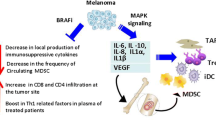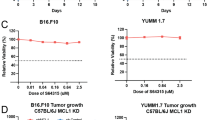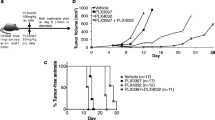Abstract
Myeloid-derived suppressor cells (MDSC) have been linked to loss of immune effector cell function through a variety of mechanisms such as the generation of reactive oxygen and nitrogen species and the production of inhibitory cytokines. Our group has shown that signaling through Bruton’s tyrosine kinase (BTK) is important for MDSC function. Ibrutinib is an orally administered targeted agent that inhibits BTK activation and is currently used for the treatment of B cell malignancies. Using a syngeneic murine model of melanoma, the effect of BTK inhibition with ibrutinib on the therapeutic response to systemic PD-L1 blockade was studied. BTK was expressed by murine MDSC and their activation was inhibited by ibrutinib. Ibrutinib was not directly cytotoxic to cancer cells in vitro, but it inhibited BTK activation in MDSC and reduced expression of inducible nitric oxide synthase (NOS2) and production of nitric oxide. Ibrutinib treatments decreased the levels of circulating MDSC in vivo and increased the therapeutic efficacy of anti-PD-L1 antibody treatment. Gene expression profiling showed that ibrutinib decreased Cybb (NOX2) signaling, and increased IL-17 signaling (upregulating downstream targets Mmp9, Ptgs2, and S100a8). These results suggest that further exploration of MDSC inhibition could enhance the immunotherapy of advanced melanoma.
Précis
Inhibition of Bruton’s tyrosine kinase, a key enzyme in myeloid cellular function, improves therapeutic response to an anti-PD-L1 antibody in an otherwise fairly resistant murine melanoma model.







Similar content being viewed by others
References
Bissell MJ, Hines WC (2011) Why don’t we get more cancer? A proposed role of the microenvironment in restraining cancer progression. Nat Med 17(3):320–329
Trikha P, Plews RL, Stiff A et al (2016) Targeting myeloid-derived suppressor cells using a novel adenosine monophosphate-activated protein kinase (AMPK) activator. Oncoimmunology 5(9):e1214787
Youn JI, Nagaraj S, Collazo M, Gabrilovich DI (2008) Subsets of myeloid-derived suppressor cells in tumor-bearing mice. J Immunol 181(8):5791–5802
Trikha P, Carson WE III (2014) Signaling pathways involved in MDSC regulation. Biochim Biophys Acta (BBA)-Rev Cancer. 1:55–65
Mandruzzato S, Solito S, Falisi E et al (2009) IL4Rα+ myeloid-derived suppressor cell expansion in cancer patients. J Immunol 182(10):6562–6568
Vuk-Pavlović S, Bulur PA, Lin YI et al (2010) Immunosuppressive CD14+ HLA-DRlow/− monocytes in prostate cancer. Prostate 70(4):443–455
Markowitz J, Brooks TR, Duggan MC et al (2015) Patients with pancreatic adenocarcinoma exhibit elevated levels of myeloid-derived suppressor cells upon progression of disease. Cancer Immunol Immunother 64(2):149–159
Zhang S, Ma X, Zhu C, Liu L, Wang G, Yuan X (2016) The role of myeloid-derived suppressor cells in patients with solid tumors: a meta-analysis. PLoS ONE 11(10):e0164514
Gonda K, Shibata M, Ohtake T et al (2017) Myeloid-derived suppressor cells are increased and correlated with type 2 immune responses, malnutrition, inflammation, and poor prognosis in patients with breast cancer. Oncol Lett 14(2):1766–1774
Parker KH, Beury DW, Ostrand-Rosenberg S (2015) Myeloid-derived suppressor cells: critical cells driving immune suppression in the tumor microenvironment. Adv Cancer Res 128:95–139
Khair DO, Bax HJ, Mele S et al (2019) Combining immune checkpoint inhibitors: established and emerging targets and strategies to improve outcomes in melanoma. Front Immunol 10:453
Pardoll DM (2012) The blockade of immune checkpoints in cancer immunotherapy. Nat Rev Cancer 12(4):252–264
Hodi FS, O’day SJ, McDermott DF et al (2010) Improved survival with ipilimumab in patients with metastatic melanoma. New Eng J Med 363(8):711
Topalian SL, Sznol M, McDermott DF et al (2014) Survival, durable tumor remission, and long-term safety in patients with advanced melanoma receiving nivolumab. J Clin Oncol 32(10):1020
Robert C, Schachter J, Long GV et al (2015) Pembrolizumab versus ipilimumab in advanced melanoma. N Engl J Med 372(26):2521–2532
Tawbi HA, Forsyth PA, Algazi A et al (2018) Combined nivolumab and ipilimumab in melanoma metastatic to the brain. N Engl J Med 379(8):722–730
Mueller H, Stadtmann A, Van Aken H et al (2010) Tyrosine kinase Btk regulates E-selectin–mediated integrin activation and neutrophil recruitment by controlling phospholipase C (PLC) γ2 and PI3Kγ pathways. Blood J Am Soc Hematol 115(15):3118–3127
Lee KG, Xu S, Kang ZH et al (2012) Bruton’s tyrosine kinase phosphorylates Toll-like receptor 3 to initiate antiviral response. Proc Natl Acad Sci 109(15):5791–5796
Bunt SK, Clements VK, Hanson EM, Sinha P, Ostrand-Rosenberg S (2009) Inflammation enhances myeloid-derived suppressor cell cross-talk by signaling through Toll-like receptor 4. J Leukoc Biol 85(6):996–1004
Pal Singh S, Dammeijer F, Hendriks RW (2018) Role of Bruton’s tyrosine kinase in B cells and malignancies. Mol Cancer 17(1):1–23
Stiff A, Trikha P, Wesolowski R et al (2016) Myeloid-derived suppressor cells express bruton’s tyrosine kinase and can be depleted in tumor-bearing hosts by ibrutinib treatment ibrutinib impairs MDSC generation and function. Cancer Res 76(8):2125–2136
Herman SEM, Mustafa RZ, Gyamfi JA et al (2014) Ibrutinib inhibits BCR and NF-κB signaling and reduces tumor proliferation in tissue-resident cells of patients with CLL. Blood J Am Soc Hematol 123(21):3286–3295
Byrd JC, Furman RR, Coutre SE et al (2013) Targeting BTK with ibrutinib in relapsed chronic lymphocytic leukemia. N Engl J Med 369(1):32–42
Chang BY, Huang MM, Francesco M et al (2011) The Bruton tyrosine kinase inhibitor PCI-32765 ameliorates autoimmune arthritis by inhibition of multiple effector cells. Arthritis Res Ther 13(4):1–15
Apolloni E, Bronte V, Mazzoni A et al (2000) Immortalized myeloid suppressor cells trigger apoptosis in antigen-activated T lymphocytes. J Immunol 165(12):6723–6730
Mundy-Bosse BL, Young GS, Bauer T et al (2011) Distinct myeloid suppressor cell subsets correlate with plasma IL-6 and IL-10 and reduced interferon-alpha signaling in CD4+ T cells from patients with GI malignancy. Cancer Immunol Immunother 60(9):1269–1279
Zhu J, Inomata T, Fujimoto K et al (2021) Ex Vivo-induced bone marrow-derived myeloid suppressor cells prevent corneal allograft rejection in mice. Invest Ophthalmol Vis Sci 62(7):3
Liu X, Quan N (2015) Immune cell isolation from mouse femur bone marrow. Bio Protoc 5(20):e1631–e1631
Schneider CA, Rasband WS, Eliceiri KW (2012) NIH image to imagej: 25 years of image analysis. Nat Methods 9(7):671–675
Rane D, Carlson EJ, Yin Y, Peterson BR. Fluorescent detection of peroxynitrite during antibody-dependent cellular phagocytosis. In: Methods in Enzymology. Vol 640. Elsevier; 2020:1–35.
Knewtson KE, Rane D, Peterson BR (2018) Targeting fluorescent sensors to endoplasmic reticulum membranes enables detection of peroxynitrite during cellular phagocytosis. ACS Chem Biol 13(9):2595–2602
Corzo CA, Cotter MJ, Cheng P et al (2009) Mechanism regulating reactive oxygen species in tumor-induced myeloid-derived suppressor cells. J Immunol 182(9):5693–5701
Stiff A, Trikha P, Mundy-Bosse B et al (2018) Nitric oxide production by myeloid-derived suppressor cells plays a role in impairing fc receptor-mediated natural killer cell function MDSC inhibit antibody therapy via nitric oxide production. Clin Cancer Res 24(8):1891–1904
Serafini P, Borrello I, Bronte V. Myeloid suppressor cells in cancer: recruitment, phenotype, properties, and mechanisms of immune suppression. In: Seminars in Cancer Biology. Vol 16. Elsevier; 2006:53–65.
Schneider T, Sevko A, Heussel CP et al (2015) Serum inflammatory factors and circulating immunosuppressive cells are predictive markers for efficacy of radiofrequency ablation in non-small-cell lung cancer. Clin Exp Immunol 180(3):467–474
Wesolowski R, Markowitz J, Carson WE (2013) Myeloid derived suppressor cells–a new therapeutic target in the treatment of cancer. J Immunother Cancer 1(1):1–11
Melani C, Sangaletti S, Barazzetta FM, Werb Z, Colombo MP (2007) Amino-biphosphonate–mediated MMP-9 inhibition breaks the tumor-bone marrow axis responsible for myeloid-derived suppressor cell expansion and macrophage infiltration in tumor stroma. Cancer Res 67(23):11438–11446
Srikrishna G (2012) S100A8 and S100A9: new insights into their roles in malignancy. J Innate Immun 4(1):31–40
Bercusson A, Colley T, Shah A, Warris A, Armstrong-James D (2018) Ibrutinib blocks Btk-dependent NF-ĸB and NFAT responses in human macrophages during Aspergillus fumigatus phagocytosis. Blood J Am Soc Hematol 132(18):1985–1988
Fraietta JA, Beckwith KA, Patel PR et al (2016) Ibrutinib enhances chimeric antigen receptor T-cell engraftment and efficacy in leukemia. Blood J Am Soc Hematol 127(9):1117–1127
Arneth B (2019) Tumor microenvironment. Medicina (B Aires) 56(1):15
Veglia F, Hashimoto A, Dweep H et al (2021) Analysis of classical neutrophils and polymorphonuclear myeloid-derived suppressor cells in cancer patients and tumor-bearing mice. J Exp Med 218(4):1
Boivin G, Faget J, Ancey PB et al (2020) Durable and controlled depletion of neutrophils in mice. Nat Commun 11(1):2762
Weber R, Fleming V, Hu X, et al. Myeloid-derived suppressor cells hinder the anti-cancer activity of immune checkpoint inhibitors. Front Immunol. 2018:1310.
Kim K, Skora AD, Li Z et al (2014) Eradication of metastatic mouse cancers resistant to immune checkpoint blockade by suppression of myeloid-derived cells. Proc Natl Acad Sci 111(32):11774–11779
Fleming V, Hu X, Weller C et al (2019) Melanoma extracellular vesicles generate immunosuppressive myeloid cells by upregulating PD-L1 via TLR4 signaling induction of immunosuppression by extracellular vesicles. Cancer Res 79(18):4715–4728
Lu X, Horner JW, Paul E et al (2017) Effective combinatorial immunotherapy for castration-resistant prostate cancer. Nature 543(7647):728–732
Holtzhausen A, Harris W, Ubil E et al (2019) TAM family receptor kinase inhibition reverses MDSC-mediated suppression and augments anti–PD-1 therapy in melanoma TAM RTK inhibition reverses MDSC suppression and augments PD-1. Cancer Immunol Res 7(10):1672–1686
Grauers Wiktorin H, Nilsson MS, Kiffin R et al (2019) Histamine targets myeloid-derived suppressor cells and improves the anti-tumor efficacy of PD-1/PD-L1 checkpoint blockade. Cancer Immunol Immunother 68(2):163–174
Highfill SL, Cui Y, Giles AJ et al (2014) Disruption of CXCR2-mediated MDSC tumor trafficking enhances anti-PD1 efficacy. Sci Transl Med. 6(237):ra67-237
Zhou J, Liu M, Sun H et al (2018) Hepatoma-intrinsic CCRK inhibition diminishes myeloid-derived suppressor cell immunosuppression and enhances immune-checkpoint blockade efficacy. Gut 67(5):931–944
Benner B, Quiroga DM, Good L, et al. A pilot study of Bruton’s tyrosine kinase inhibitor ibrutinib alone and in combination with PD-1 inhibitor nivolumab in patients with metastatic solid tumors. 2020.
Young MRI. Th17 cells in protection from tumor or promotion of tumor progression. J Clin Cell Immunol. 2016;7(3).
Wen L, Gong P, Liang C et al (2016) Interplay between myeloid-derived suppressor cells (MDSCs) and Th17 cells: foe or friend? Oncotarget 7(23):35490
Ma M, Huang W, Kong D (2018) IL-17 inhibits the accumulation of myeloid-derived suppressor cells in breast cancer via activating STAT3. Int Immunopharmacol 59:148–156
Li J, Liu J, Mao X, Tang Q, Lu H (2014) IL-7 receptor blockade inhibits IL-17-producing γδ cells and suppresses melanoma development. Inflammation 37(5):1444–1452
Long M, Beckwith K, Do P et al (2017) Ibrutinib treatment improves T cell number and function in CLL patients. J Clin Invest 127(8):3052–3064
Acknowledgements
SS—NIH T32AI 106704-01A1, CA—NIH 1T32 GM139784-01A1, DS—AUA Urology Care Foundation Research Scholars Award, WEC—NCI UM1CA186712
Funding
National Institutes of Health,T32AI 106704-01A1,1T32 GM139784-01A1,T32AI 106704-01A1,American Urological Association Foundation, Urology Care Foundation Research Scholars Award, National Cancer Institute, UM1CA186712
Author information
Authors and Affiliations
Contributions
Conceptualization: SHS, DA, WEC Data Curation: SHS, CDA, HS, DS, DA, BB, MJD, MD, FC, PT, GL, KLK, CC Formal Analysis: SHS, CDA, HS, DS, DA, MD, PT, GL, LY, JZ, CC Funding Acquisition: DS, WEC Investigation: SHS, CDA, HS Methodology: SHS, CDA, HS, WEC Project Administration: WEC Resources: KLK, WEC Supervision: WEC Visualization: SHS, CDA, HS, DA Writing - Original Draft Preparation: SHS, CDA, HS, DS, DA, WEC Writing - Review and Editing: All authors
Corresponding author
Ethics declarations
Conflict of interests
The authors declare no potential conflicts of interest.
Additional information
Publisher's Note
Springer Nature remains neutral with regard to jurisdictional claims in published maps and institutional affiliations.
Rights and permissions
Springer Nature or its licensor (e.g. a society or other partner) holds exclusive rights to this article under a publishing agreement with the author(s) or other rightsholder(s); author self-archiving of the accepted manuscript version of this article is solely governed by the terms of such publishing agreement and applicable law.
About this article
Cite this article
Sun, S.H., Angell, C.D., Savardekar, H. et al. BTK inhibition potentiates anti-PD-L1 treatment in murine melanoma: potential role for MDSC modulation in immunotherapy. Cancer Immunol Immunother 72, 3461–3474 (2023). https://doi.org/10.1007/s00262-023-03497-1
Received:
Accepted:
Published:
Issue Date:
DOI: https://doi.org/10.1007/s00262-023-03497-1




